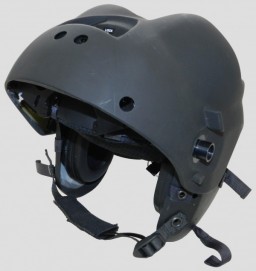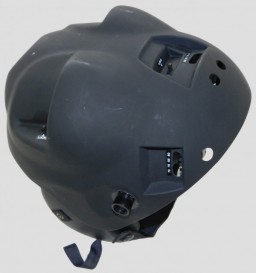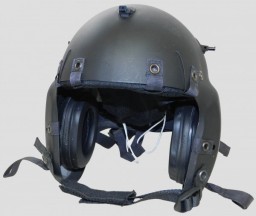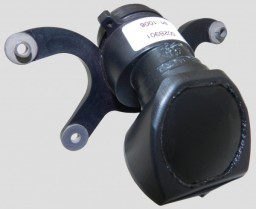In 1992 the Viper™ family of HMD’s was commenced comprising a range of visor projected systems from the Monocular Viper™ I, the Binocular Viper™ II, the NVG Viper™ 3 (Also called ‘Night Viper) and the monocular Viper™ IV. The family of helmet systems has now been renamed Striker®.
Viper™ I: This was a lightweight monocular visor projected Helmet Mounted Sight. The spherical visor is a standard aircrew visor but has a dichroic patch on the right-hand side which combines and reflects dynamic flight data symbology to the pilot. The source is a high efficiency miniature “1 inch” CRT displays which projects via an optical relay assembly to the visor. The optical system gives a 20degree field of view. The helmet shell was a one piece unit and was fitted with a magnetic head tracker system.
Viper™ II: This was a lightweight binocular visor projected Helmet Mounted Display. The visor combines and reflects dynamic flight data symbology and raster information to the pilot, projected from two high efficiency miniature “1 inch” CRT displays via two optical relay assemblies. The highly efficient optical design allows the use of a standard spherically curved aircrew visor, with a 70% transmission neutral density partially reflecting combiner coating. The visor coating ensures high display brightness, while maintaining high real world transmission with no colouration. Use of a spherical visor shape means display accuracy is insensitive to visor rotation, thus enabling partial raising of the visor and still maintaining an accurate display. It provided 40° FOV with full overlap, a 15-mm exit pupil, and a 70-mm eye relief. Excluding the oxygen mask, it weighed 4.2 lbs (1.9 kg). The Viper™ II display module can be fitted to all sizes of USAF and USN fixed wing helmets and uses existing liner systems. The optical relay system for each eye channel can be adjusted for individual inter-pupillary settings with no changes or modifications to the visor. When coupled to a suitable Head Tracking System, such as the GEC-Marconi Avionics DC Magnetic System, the Viper™ II system can provide full space stabilised symbology and video pictures.
Viper™ 3: (Note that the Roman III was not used for this HMD which was also known as ‘Night Viper’) This HMD was designed in collaboration with Delft in the Netherlands and was a visor-projected NVG replacement. The Viper 3 exploits the visor projection scheme common to HMDs and employs multiple-folded optical paths to carry the imagery from a pair of 18-mm Image Intensifier tubes to the pilot's spherical visor. This provides the pilot with an unobstructed binocular 40° FOV NVG capability on his see through visor. The Image Intensifier tubes are mounted on the sides of the helmet, to provide the best possible balance for low fatigue and safe ejection. The helmet is considered suitable for loads of up to 5-6Gs. An important feature of the optical design of the Viper 3 is that the addition of a dichroic beamsplitter to one of the mirrors in the optical path between the image intensification tubes and the visor allows the addition of a CRT to the Viper 3 design so that the system can become a combined projection HMD and NVG package, with the addition of a CRT and head tracking sensors. The addition of a CRT adds some weight but improves the centre-of-mass of the overall system. The Viper 3 design solves the principal problems associated with conventional clip-on ANVIS. The HMD had a two part shell with the inner form fitted for the pilot and the outer holding the optical system. The HMD was first flight tested in a Dutch Air Force F-16.
Viper™ IV: This HMD has a monocular visor projected display giving a 40degree field of view. The HMD was used in extensive trials on the United States Air Force Research Laboratory's NF-16D Variable-stability In-flight Simulator Test Aircraft (VISTA). The Viper™ IV Helmet-Mounted Optics Module was integrated with a modified Helmet Integrated Systems Limited (HISL) HGU-86/P helmet, the Honeywell Advanced Metal Tolerant tracker, and a Marconi Avionics Programmable Display Generator. Other flight tests have been on the EPAF MLU F-16, AV-8B and Tornado.









